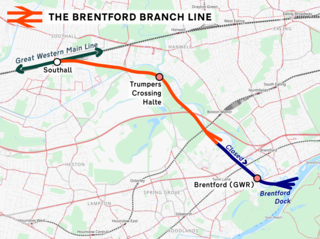
The North Tyneside Steam Railway and Stephenson Steam Railway are visitor attractions in North Tyneside, North East England. The museum and railway workshops share a building on Middle Engine Lane adjacent to the Silverlink Retail Park. The railway is a standard gauge line, running south for 2 miles (3.2 km) from the museum to Percy Main. The railway is operated by the North Tyneside Steam Railway Association (NTSRA). The museum is managed by Tyne and Wear Archives and Museums on behalf of North Tyneside Council.

Feniton railway station serves the village of Feniton in Devon, England. It was opened by the London and South Western Railway (LSWR) in 1860 but is now operated by South Western Railway which provides services on the West of England Main Line. It is 159 miles 24 chains (256.4 km) down the line from London Waterloo.

Salisbury railway station serves the city of Salisbury in Wiltshire, England. It is 83 miles 43 chains (134.4 km) from London Waterloo on the West of England line to Exeter St Davids. This is crossed by the Wessex Main Line from Bristol Temple Meads to Southampton Central. The station is operated and served by South Western Railway (SWR), and is also served by Great Western Railway (GWR).

Backworth is a village in the metropolitan borough of North Tyneside in the county of Tyne and Wear, England, about 3+1⁄2 miles (6 km) west of Whitley Bay on the north east coast. It lies 5 miles (8 km) northeast of Newcastle. Other nearby towns include North Shields to the southeast, Wallsend to the south, and Cramlington to the northwest.
The North Tyneside Loop refers to the railway lines in North Tyneside from Newcastle upon Tyne via Wallsend, North Shields, Whitley Bay, Backworth, Benton and South Gosforth back to Newcastle. Since the 1980s, it has formed part of the Tyne and Wear Metro, albeit in modified form.
The Blyth and Tyne Railway was a railway company in Northumberland, England, incorporated by Act of Parliament on 30 June 1852. It was created to unify the various private railways and waggonways built to carry coal from the Northumberland coalfield to Blyth and the River Tyne, which it took control of on 1st January 1853. Over time, the railway expanded its network to reach Morpeth (1857/8), North Seaton (1859), Tynemouth (1860/1), Newcastle upon Tyne (1864), and finally Newbiggin-by-the-Sea (1872). It became part of the much larger North Eastern Railway in 1874.
The Wansbeck Railway was a single track railway line in Northumberland, England, that ran from Morpeth to Reedsmouth, where it made a junction with the Border Counties Railway. Conceived as part of a through trunk route for the North British Railway, it never achieved its potential. It opened in stages from 1862 to 1865. The population was sparse and mineral traffic kept the line going.
The Holywell branch line was a railway branch line in North Wales that connected Holywell with the North Wales Coast Line at Holywell Junction. Holywell had quite a large amount of mineral resources and the branch line was built originally as a mineral railway. When the local industry declined, the line fell into disuse, but it was reopened as a tourist passenger line in 1912. Road competition made the railway non-viable and this then cauded the line to be closed in 1954.

The Brentford branch line, also known as the Brentford Dock Line, is a freight-only branch railway line in west London, England. The route, which opened in 1859, was backed by the Great Western Railway and built by the Great Western & Brentford Railway Company. It ran 4 mi (6.4 km) from Southall to Brentford Dock. In 1964, the line to the wharves was closed. The branch now runs from the Great Western Main Line to a goods yard and waste transfer station in Brentford.

The Harrogate–Church Fenton line was a railway line opened by the York and North Midland Railway between 1847 and 1848 linking Harrogate and Church Fenton.

Newcastle New Bridge Street was a railway station on the edge of the city-centre of Newcastle-upon-Tyne, England. The station was the original Newcastle terminus of the Blyth and Tyne Railway, and was opened on 27 June 1864. In 1874 the Blyth & Tyne was taken over by the North Eastern Railway. For most of its life it served trains to Tynemouth and Morpeth. Picton House, a villa designed by John Dobson, was used for company offices and passenger facilities.

Lucker railway station served the village of Lucker, Northumberland, England, from 1847 to 1965 on the East Coast Main Line.

Christon Bank railway station served the village of Christon Bank, Northumberland, England from 1847 to 1965 on the East Coast Main Line.

Little Mill railway station served the hamlet of Little Mill, Northumberland, England from 1847 to 1965 on the East Coast Main Line.
Killingworth railway station served the town of Killingworth, Tyne and Wear, England from 1847 to 1965 on the East Coast Main Line.

Hepscott railway station served the village of Hepscott, Northumberland, England, from 1858 to 1964 on the Blyth and Tyne Railway.
North Seaton railway station served the town of Ashington, Northumberland, England from 1859 to 1964 on the Blyth and Tyne Railway.
Seghill railway station served the village of Seghill, Northumberland, England from 1841 to 1965 on the Blyth and Tyne Railway.
Niddrie railway station served the suburb of Niddrie, Edinburgh, Scotland from 1843 to 1950 on the Edinburgh and Dalkeith Railway.

Tow Law railway station served the town of Tow Law, County Durham, England, from 1847 to 1965 on the Stanhope and Tyne Railway.












